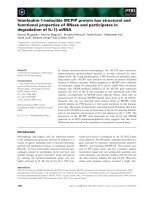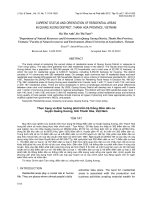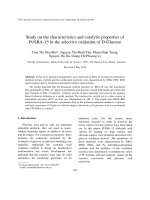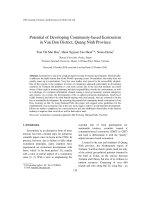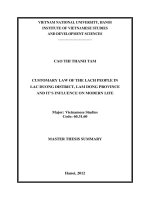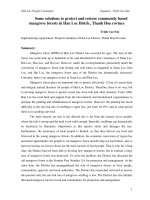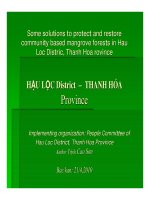Soil properties of dendrocalamus barbatus forests in quan hoa district thanh hoa province
Bạn đang xem bản rút gọn của tài liệu. Xem và tải ngay bản đầy đủ của tài liệu tại đây (617.22 KB, 46 trang )
AKNOWLEDGEMENT
This thesis was completed at the University of Forestry Vietnam in 2015.Be consented
of the university, of forest resources and the environment management faculty, I perform
thesis topic: “Soil properties of Dendrocalamusbarbatus forests in QuanHoa district,
ThanhHoa province”.
In the process of implementation and completion of the thesis, thanks to the attention
and enthusiastic help of administrators, boards of VFU, Silviculture department. In addition, I
also received enthusiastic help of the Department of Agriculture and Rural Development in
ThanhHoa Province, Forest Branch in ThanhHoa, ThanhHoa Forestry Department, and
government and local inQuanHoa district, ThanhHoa province has provided the necessary
information, provided facilities for collecting the data in the field. Thank for all those precious
helping.
In particular, I would like to express deep gratitude and respect to A.Prof.Dr. Pham
Van Dien as a science instructor who spent a lot of time, effort and dedicated guidance with
your comments valuable, help me accomplish this thesis. I also express my thanks to Dr. Bui
ThiHuyen (Hong Duc University) who provided and together collected data for this thesis.
I would like to thank to the family, friends and colleagues have always encouraged me
during the implementation of the thesis.
Sincerely thank!
Hanoi, September 2015.
Student:
Do ThanhHai
CONTENT
I. INTRODUCTION .................................................................................................................................... 1
II. STUDY SITE........................................................................................................................................... 3
2.1. Natural condition ................................................................................................................................... 3
2.1.1. Geographical location ........................................................................................................................ 3
2.1.2. Terrain ................................................................................................................................................. 3
2.1.3. Climate - Hydrology .......................................................................................................................... 4
2.1.4. Geology and soil ................................................................................................................................ 5
2.1.5. Land and forest resources .................................................................................................................. 5
2.2. Economic characteristics – society...................................................................................................... 6
2.2.1. Residential Features ........................................................................................................................... 6
2.2.2. Economic Characteristics .................................................................................................................. 6
2.3. Reviews and overall assessment .......................................................................................................... 7
2.3.1. Advantages and opportunities for intensive Dendrocalamusbarbatus forest ............................... 7
2.3.2. Difficulties and restrictions for Dendrocalamusbarbatus forest intensification........................... 7
III. OBJECTIVES AND SCOPE OF THE STUDY................................................................................ 8
3.1. Objectives............................................................................................................................................... 8
3.2. Scope of the study ................................................................................................................................. 8
IV. METHODS............................................................................................................................................. 9
4.1. Methodology Research Issues ............................................................................................................. 9
4.2. Specific research methods .................................................................................................................. 10
4.2.1. Data collection .................................................................................................................................. 10
4.2.2. Methods of Data Processing ........................................................................................................... 14
V. RESULTS AND DISCUSSIONS....................................................................................................... 16
5.1. Characteristics of Dendrocalamusbarbatus forest site conditions .................................................. 16
5.1.1. Climate and topographic ................................................................................................................. 16
5.1.2. Growth characteristics of Dendrocalamusbarbatus forests ..................................................... 18
5.2. Soil properties of Dendrocalamusbarbatus forests. ........................................................... 22
5.3. The standard to classify site condition according to suitable level for planting
Dendrocalamusbarbatus. ............................................................................................................ 24
VI. CONCLUSIONS. ................................................................................................................................ 30
VII. REFERENCES
APPENDIX
LIST OF TABLE
Table 4. 1. Distribution of plots according 9 communes of QuanHoa district. Appendix 03. . 11
Table 5.1. Some climate factors research areain 3 years from 2013 to 2015 ........................... 16
Table 5.2. The topographic characteristic of Dendrocalamus barbatus forest in Quan Hoa ... 17
Table 5.3. Area, distubution, cover of Dendrocalamus barbatus forests in Quan Hoa ............ 19
Table 5.4. Density of Dendrocalamusbarbatus forest in QuanHoa .......................................... 20
Table 5.5. Growth quantities of Dendrocalamus barbatus forest ............................................. 21
Table 5.6.The characteristics of soil to Dendrocalamus barbatus forest in Quan Hoa............. 22
Table 5.7. The standard of classified terrain condition according to suitable level for
Dendrocalamusbarbatus forest ................................................................................................. 28
Table 5.8. Determining the appropriate levels for Dendrocalamus barbatus forest plots ........ 29
LIST OF FIGURE
Figure 4.1. The relationship between the content in intensive forest. ........................................ 9
Figure 4.2. How to approach and solve the content of the thesis. ............................................ 10
Figure 5.1. Dendrocalamusbarbatus forest in Hoi Xuan commune, QuanHoa district ............ 18
Figure 5.2. Scatter chart reflects the relationship of DBH, H with topographic factors and soil
properties. ................................................................................................................................. 26
ABSTRACT
The study have been carrying out in the forests of 08 communes concentrate
Dendrocalamusbarbatus forest and 01 town of QuanHoa district include: Town, XuanPhu,
Hoi Xuan, Phu Nghiem, Nam Xuan, PhuXuan, Nam Dong, Nam Tien and ThanhXuan.I
completed this research with practical observations, collect data and analyze soil samples,
growth of Dendrocalamusbarbatus forest. These goals are completed include:(1)To research
on forest characteristics of Dendrocalamusbarbatus forest (climate, terrain, vegetation of
Dendrocalamusbarbatus forests).(2)To research soil properties of Dendrocalamusbarbatus
forest.(3)To propose the standard to classify site condition according to suitable level for
planting Dendrocalamusbarbatus. Results showed: Dendrocalamusbarbatus forest in
QuanHoa should be taken care to have larger average diameter, improving the economic
value andfeatures of grown soil for planting Dendrocalamusbarbatus is acidity and nutrientpoor soil. Results collected from the growth of Dendrocalamusbarbatus forests and soil
properties, I wrote the correlated equation: Y = 38,689(Z/Sl)0,14502(R2 = 0,82, F = 90,4).
Therefore, the work propose just only planting Dendrocalamusbarbatus in suitable high and
medium terrain condition is S1 and S2.
I. INTRODUCTION
Soil is an important component of the ecosystem. It means so much to the ability of
providing water, minerals, and nutrients for plants. So it can affect the growth and
development of plants. Each type of soil will have a special kind of vegetation. However,
each type of vegetation would characterize for a specific soil. Soil types vary by variety of
indicators such as: color, physical properties, chemical. Basic characteristics of soil fertility
reflected: composition mechanical, soil structure, moisture, soil layer thickness, and chemical
properties of the soil.
ThanhHoa province has many Dendrocalamusbarbatus forests. According to data
from the current state of forests and forest land in ThanhHoa province, 2013, the
Dendrocalamusbarbatus forest area of ThanhHoa in 2012 is 70257.08 hectares, occupied for
39.9% of the province's forest plantations. In addition to protection functions, the effect of
bamboo forest are: supply trunk for the construction, paper materials, plywood, wicker
materials, ...; provide bamboo sprout for food; trunk charcoal used as activated
charcoal; sawdust used for growing mushrooms ... Because of the diversity of products that
are demanding to the market, source of revenue from Dendrocalamusbarbatus forest become
more significantly with the livelihood of local people. So Dendrocalamusbarbatuswas chosen
as the main forest plants in ThanhHoa Province, the area of its forest is increasingly
expanded.
Stemming from the idea that there should be further studies on the nature of forest
land to see the effects of forest vegetation to the land of Dendrocalamusbarbatus forest, to
restore forest ecosystems and sustainable development in using land. It also recommends
approaches to improve soil quality, productivity and quality ofDendrocalamusbarbatus
forest. For
that
reason,
Imade
a
decision
to
study
on "Soil
properties
of
DendrocalamusbarbatusDendrocalamusbarbatus forests in QuanHoa district, ThanhHoa
province".
1
The direction of the research is focused on some scientific base on divide the land
suitable condition for plant Dendrocalamusbarbatus. Because of limited time and budget,
subject only perform at 9 communes in QuanHoa district, where Dendrocalamusbarbatus
forest areas are quite concentrated.
2
II. STUDY SITE
2.1. Natural condition
2.1.1. Geographical location
QuanHoa is mountainous, border, the center of ThanhHoa province is 137 km to the
northwest, in the direction of 47 Highway and 15A Highway.
Geographical location:
- From 200 16 '30 "to 200 19' 30" North latitude
- Since 1400 44 '00 "to 105011' 30" East longitude
Contiguous boundary:
- The North bounded by Son La and HoaBinh.
-TheSouth bounded by Quan Son district.
- The Eastern borders by Ba Thuoc district.
- The West borders by MuongLat district and the Lao PDR - Having long border is over 6 km.
In the district, there are 15A highway 520, 521 road run through connecting with Ba
Thuoc district, MuongLat district, HoaBinh, Son La province and Laos, but the location is
quite far from the district administrative center ThanhHoa province and major restrictions on
economic exchanges - cultural - social with districts and neighboring provinces should remain
a poor district.
2.1.2. Terrain
Complex terrain, stretching from northeast to northwest with the massive limestone
mountains, craggy, have many side thunderstorm created many streams. All streams flow into
two major are Dendrocalamusbarbatus and Ma river.
Due to the natural conditions, mountain, river terrain divided into 3 sub-regional produce have
different characteristics:
3
- Dendrocalamusbarbatus river zones: 6 communes of Nam Xuan; Nam Tien; Nam Dong;
ThienPhu; Hien Chung and HienKhiet.
- Ma River zones: comprised of 8 communes of ThanhXuan; PhuXuan; Phu Le; Phu Son;
PhuThanh; TrungThanh; Thanh Son and Trung Son.
- Center zones: Towns, 03 communes (XuanPhu, Phu Nghiem; Hoi Xuan) and the agencies
and administrative units, is the center of economy, politics of the District.
QuanHoa district has complex terrain steep, rugged, dense river network. Bound by the Ma
River basin, river flows and small rivers form the sub-region so isolated, the whole district is
divided into 3 sub terrain.
QuanHoa has an area of steep hills on 200accounted for 50%; slope area from 15-200
accounted for more than 30%; slope area from 8-150 account for more than 13% and slope
area smaller than 80 accounted for nearly 7% of the total natural area of the district.
2.1.3. Climate - Hydrology
2.1.3.1. Climate
QuanHoa district has tropical highland climate and weather features affected the North
West region than the North Central and the old four zones; the annual average temperature
between 22 - 230C. Total rainfall ranged from 1.600 - 1.900mm. Climate is divided into two
distinct seasons: rainy and dry seasons.
Dry season: lowest humidity early occurs in January or December (down to 19-40%).
Weather is very cold, ground water decreases, streams are dry. Drought regularly occurs and
lasts from November to April the following year.
Rainy season: hot weather, accompanied by winds dry pipe burning, affecting production and
the risk of forest fires. As districts with high rainfall regimes, the average annual rainfall from
1600 - 1760mm, unevenly distributed between the months of the year and between regions
within the district; more rain and high rainfall concentrated from June to October, often
4
flooding, flash flood caused landslides, washed away crops, destruction of irrigation works,
roads and crops, influence people's production and transportation.
2.1.3.2. Hydrological
QuanHoa has plentiful river systems with two big rivers which flow through the
territory of Ma and Dendrocalamusbarbatus River; large streams such as Khiet stream, Kho
stream, On stream, Pu stream, Pao stream, Quyt stream, Pung stream ... and dozens of other
small streams. Streams are usually dry in the dry season, flash floods during the rainy season,
affecting production and livelihood. However this is possible resources to build hydropower
plants and irrigation investment if well exploited.
2.1.4. Geology and soil
QuanHoa has geological structure of stones are: magma and neutral alkaline, clay
schist and sandstone. There are 3 main types of soil:
+ Yellow feralit, yellow gray grow on alkaline magma and neutral.
+ Brown yellow feralit, grow on clay schist.
+ Humus at 800m altitude, soil deposits in the foothills and along many rivers and streams.
The average soil layer thickness from 50-100 cm, mechanical components mainly medium
loam, stone and average rate. Overall land is suitable for many crops, especially forestry crops
including Dendrocalamusbarbatus plant.
2.1.5. Land and forest resources
According to statistics of the land on 01/01/2011 (Environment and Natural
Resources). QuanHoa has a total area of 99,013.68 hectares of natural and forest land is
82494.96 hectares, accounting for 83.3% of natural land area. In that land, 41814.84 hectares
of production forests are accounting for 50.6% of the area of forest land, agricultural land
accounts for 4.0% 3953.49 ha of natural land area; forest coverage reached 80.6%.
5
Production forests are major Dendrocalamusbarbatus crops 25.857.61ha area, this is the
spearhead forest districts in recent years for exploiting each year over 7 million trees,
Dendrocalamusbarbatus products became goods, bringing efficient economy for farmers.
Thanks to the variety of ecological factors, topography and soil that flora and fauna in the
district are quite diversity and rich, concentrated mainly in the nature reserve of Pu Hu and
PuDendrocalamusbarbatus. There are still some rare animal species such as gaur, leopards,
bears ... and also very rich flora with many species of medicinal plants and rare wood.
2.2. Economic characteristics – society
2.2.1. Residential Features
The whole district has 17 communes and 01 villages with 123 towns / villages; total
number of households is 10,269 households, total import was 46 121 people (according to the
population census of 01/4/2010), with five ethnic groups live are: Thai (representing 66.49%),
Muong (occupied 24.11%), Kinh (accounting for 7.48%), Mong (representing 1.58%) and
Hoa (accounting for 0.34%). There are 14/18 communes located in the Government's program
and 99 135 villages is in the particularly difficult confition.
2.2.2. Economic Characteristics
Due to the natural conditions, mountain, river terrain divided into 3 sub-regional
produce have different characteristics, formed three regional economic zone of the district
communes.
- Economic Dendrocalamusbarbatus River zone. These zone have much arable land and
relative equality. The advantage are Dendrocalamusbarbatus trees and rice areas of the
district.
-
Economic Ma river zone: Topography is more than 90% slope, the area field is less, the
advantage is Dendrocalamusbarbatus trees, cattle raising and cultivation of upland crops in
upland hill.
6
-
The center of Economic zones: The advantages are developing industry, handicrafts and
services. In agriculture and forestry production are many programs and projects to support
success. Dendrocalamusbarbatus plant is strong in agriculture and forestry production.
QuanHoa district is poor, economic grows slowly. The total annual food production (20112013) average of 17741 tones. Average food reaches 383kg / person / year. Average income is
6.397 million dong/person/year.
2.3. Reviews and overall assessment
2.3.1. Advantages and opportunities for intensive Dendrocalamusbarbatus forest
- Natural environment (geography, topography, climate) shows QuanHoa high air humidity,
heavy rainfall, matching the growth and development of Dendrocalamusbarbatus plants.
2.3.2. Difficulties and restrictions for Dendrocalamusbarbatus forest intensification.
- Most of Dendrocalamusbarbatus area in the study area were planted in extensive farming
methods, growing a little each year, gradually forming Dendrocalamusbarbatus garden,
monoculture Dendrocalamusbarbatus forest. On the other hand, some are planting on the site
conditions
which
is
not
suitable
(height,
slope,
low
humidity)
therefore
Dendrocalamusbarbatus forest develops very slowly. In general, people do not have the habit
of planting in intensive methods and fertilizers so that the yield and the quality of
Dendrocalamusbarbatus forest is quite low.
7
III. OBJECTIVES AND SCOPE OF THE STUDY
3.1. Objectives
- To research on forest characteristics ofDendrocalamusbarbatus forest (climate, terrain,
growth of Dendrocalamusbarbatus forests).
- To research soil properties of Dendrocalamusbarbatus forests.
- To propose the standard to classify site condition according to suitable level for planting
Dendrocalamusbarbatus.
3.2. Scope of the study
- The object of the research study is the Dendrocalamusbarbatus stand is grown in pure
specie, not in the programs and projects from 1975 to 2004 (the Dendrocalamusbarbatus
stands are exploited stably at the start of the study) for the purpose of take trees as feedstock.
Old trees and mature trees are cut annually for technology purpose.
- Dendrocalamusbarbatus Hsueh etD.Z.Li has a synonym (Dendrocalamusmembranaceus
Munro) and belonged to the genus Dendrocalamus. It is a symposiabamboo with erect
cylindrical green stems. The nodes have one main and 2 to 5 small branches. The base of the
main branches is always swollen with developed aerial roots.
- Content: The thesis research focused on selected scientific basis and the plant quality,
classification of site condition technical weight and improving quality impacts of
Dendrocalamusbarbatus forest.
- Location: The study locations were conducted in the forests of 08 communes concentrate
Dendrocalamusbarbatus forest and 01 town of QuanHoa district includes: Town, XuanPhu,
Hoi Xuan, PhuNghiem, Nam Xuan, PhuXuan, Nam Dong, Nam Tien and ThanhXuan.
8
IV. METHODS
4.1. Methodology Research Issues
Productivity, quality and forest plantations are generally grown in particular flows
depend on many factors, such as plant variety, terrain, planting, care and exploitation.
Contents of intensive forest stream can be outlined according to the following diagram:
1. Identify site
High yield, yield stability
Productivity
and yields
Good site
management, prevent
land degradation
Breeding
2. Choose good seeds
INTENSIVE FOREST
3.Silviculture (planting,
tending, harvesting)
correct and reasonable
Figure 4.1. The relationship between the content in intensive forest.
Under this scheme, the target of intensive forest with high yield, yield stability should
satisfy three variables: first variable is determined appropriate sites under the crops. Select the
correct site conditions will ensure the principle of trees and crops are suitably planted basing
on soil property, leveraging the potential of natural and stimulated the growth of the
plantation. 2nd variable is needed good varieties for reforestation. With good quality varieties
will improve the growth of crops contribute to improving forest productivity and output.
variable 3 is the silvicultural measures for each period impacts plantations properly and
reasonably. When silvicultural impacts on forests and reasonable properly will reduce input
9
costs, promote the growth of crops, prevent soil degradation. Within the research topic
focused analysis of the first turn. Dividing site conditions mean for selected flows and
converting
farmland
alternative
tree
species
on
the
site
flows
unsuitable
for
Dendrocalamusbarbatustrees.
From the above perspective, to address the contents of the study was put out, the
research step is performed as follows.
Field survey study sites selected
Test design
Data collection
selected
Status of
Dendrocalamusbarbatus forest
Soil properties
Data processing by excel, SPSS,R
Site conditionaccording to suitable level for planting
Dendrocalamusbarbatus
Figure 4.2. How to approach and solve the content of the thesis.
4.2. Specific research methods
4.2.1. Data collection
a) Establishing sample plots
Step 1: Survey field study sites selected.
Preliminary scans the entire Dendrocalamusbarbatus forest area of QuanHoa, on that
basis, select and set up the typical sample plot 500m2 area (25 x 20 m).
The study has established 60 typical sample plots, while 20 plots in location rib foot,
20 plots in the midship location and 20 plots in rib apex position. Distribution of sample plots
listed in Table 4.1.
10
Table 4. 1. Distribution of plots according 9 communes of QuanHoa district. Appendix 03.
Dendrocalamusbarbatus forest
No
Area
Communes
2012
2004
Number of sample plots
Rib
Mid
Top
foothills
Rib
Rib
Total
1
Xuan Phu
575.80
252.70
2
2
2
6
2
Phu Nghiem
225.83
224.80
1
1
1
3
3
Nam Xuan
1786.17
1519.63
3
3
3
9
4
Hoi Xuan
1100.39
947.07
2
2
2
6
5
Nam Tien
3592.12
3060.60
3
3
3
9
6
Thanh Xuan
1992.24
1638.04
3
3
3
9
7
Nam Đong
2316.47
1992.80
3
3
3
9
8
Phu Xuan
861.28
574.05
2
2
2
6
9
Town
135.86
93.10
1
1
1
3
12586.16
10302.79
20
20
20
60
Total
Step 2. Investigate Dendrocalamusbarbatus trees in sample plots
+ Rating codes of each Dendrocalamusbarbatus cluster from one to the end
+ Rating codes of each Dendrocalamusbarbatus trees according to the cluster plant.
+ Girth measured at 1.3 m location of all trees.
+ Determining the age of tree in age 1, age 2, age 3, and greater or equal age 4 through
morphology and anatomy, in detail:
11
Age 1: Trunk is dark green, glossy, with little white powder, the section has white
pile,biogas roots at base section are pale yellow.
Age 2: Trunk is light blue with white powder, yellow brownish biogas roots
Age 3: Often appears symbiotic fungus spots, yellow green trunk.
Above age 4.5: Strong trunk, outside there are more patchiness green, white moss
compare to 3-year-old tree. The space does not have moss often yellowish or reddish.
+ Classification Dendrocalamusbarbatus trees with Standard which ThanhHoa Department of
Agriculture and Rural Development and ThanhHoamarket apply. Like this:
DendrocalamusbarbatusCategory 1: ≥ 1.3 m circumference 29cm location, length of use ≥
10m
Dendrocalamusbarbatus Category 2: The perimeter position 1.3 m from 27 - 29cm, length of
use 8-9.9m
DendrocalamusbarbatusCategory 3: Perimeter position 1.3 m from 23 – 26.9cm, length of
use 7-7.9m
Dendrocalamusbarbatus Category 4: Perimeter position 1.3 m from 19 – 22.9cm, length of
use <7.0m
DendrocalamusbarbatusCategory 5: Perimeter location 1.3 m <19cm, length of use> 2.0m
(Used length is the length of Dendrocalamusbarbatus commercial, the sale was felled tops
20%)
Step 3: Investigation of sites in sample plots
+ Measured slope, slope direction by hand compass
+ Digging soil 80cm width x length size 120cm determine soil depth.
+ Soil sampling at four points around the Dendrocalamusbarbatus clump with distance from
50 - 100cm. At each location took approximately 200g of soil at a depth of 0-30 cm, mix well
and use a portion to analyze the physical and chemical soil.
12
+ Analysis of soil samples analyzed by the usual methods of soil analysis and prevention
Hanoi Environmental Planning Institute and Design agriculture.
• pHKCl determined by pH meter metress.
• Humus total (OM%) determined by the method Chiurin.
• Total nitrogen (N%) determined according to the Kjeldahl method.
• Total Phosphorus (P2O5%) determined by the method of Bray II.
• Kali total (K2O5%) determined by the method of flame photometer.
• Protein digestion (N, mg / 100 g soil): determined by the methodKononovaTiurin.
• Phosphorus (P2O5, mg / 100 g soil): determined by the method Oniani.
• Potassium digestion (K2O, mg / 100 g soil): determined by flame photometric method.
• Adsorption capability (CEC) determined by the method of ammonium - acetate.
b) Interview method
Using interviews to collect information on planting techniques such as planting year,
seed, seedling standards, density, tillage methods, fertilizer, care, mining, the pest problems,
reviews of people about technical matters and income from Dendrocalamusbarbatus forest.
Each
commune
selected
Dendrocalamusbarbatus
and
trees,
interviewed
1
communal
3
families
technicians
participate
and
1
in
business
growing
owner
Dendrocalamusbarbatus trees. The total number of participants is 45 people interviewed.
Using semi-structured interviews were suggested form available with open questions for each
subject interviewed, the contents are as follows:
+ For social technicians. The interviews will focus on issues of technical management, policy
development priorities Dendrocalamusbarbatus tree; information about area events, distribution
of Dendrocalamusbarbatus trees in the area; situation afforestation, Dendrocalamusbarbatus
forest development; Technical measures are being applied.
13
+ For families: Are who participate in growing Dendrocalamusbarbatus trees and have
experience in this field. Content interviewing techniques are planting, tending, exploitation,
Dendrocalamusbarbatus protection they have been applied, paying special attention to the
knowledge and experience of local native. These technical measures are they best respond,
most appropriate.
+ For Business Owners Dendrocalamusbarbatus trees. The contents of the interview is to
ask the Dendrocalamusbarbatus tree, Dendrocalamusbarbatus tree on market prices,
Dendrocalamusbarbatusexploitation situation of people.
4.2.2. Methods of Data Processing
From the data collected on the sample plots and conducted tree revised standards and
calculations based on mathematical formulas in forestry statistics of Nguyen Hai Dong, Ngo
Kim Khoi, 2006, Nguyen Hai Dong, Nguyen TrongBinh, 2005, with the support of a number
of specialized software is Excel, SPSS, R.
-
Using
Excel
calculate
the
structural
indicators,
the
growth
of
established
Dendrocalamusbarbatus forest and correlation equations.
- Using the Levene standard on SPSS software to test for equality of variance of the sample in
the test formula.
- Using the Pairs on software R to establish scatter charts
a) Research Dendrocalamusbarbatus forest status
- Identification of:
+ The number of clusters / ha, using the formula: Nk = nk .10000
S
Nc= nc .10000
+ Number of Trees /ha, using the formula:
Note:
S
Nk is the number of clusters / ha; Nc is the number of trees / ha
Nk is the average number of clusters in the sample plots
14
Nc is the average number of trees in the sample plots
S is the area of sample plots
b) Research division suitable Dendrocalamusbarbatus sites afforestation
Based on the evaluation of the factors affecting the site to commercial quality
standards of forest and Dendrocalamusbarbatus standards of ecological growth to find out the
main factors affecting the productivity and quality of Dendrocalamusbarbatusforest, from
which formulate criteria for dividing up the field.
Step 1: To make the link between the site factors to terms of ecological growth with scatter
chart.
Step 2: Determine the site factors that affect growth through scatter diagram and correlation
equations set.
Step 3: Divide the site into 3 levels according to Dendrocalamusbarbatusforest commercial
quality of grain crops.
S1: The site for achieving trees Dendrocalamusbarbatus type 1 and type 2 - Well suited
S2: The site to reach category 3 Dendrocalamusbarbatusplants - Suitable medium
S3: The site for theDendrocalamusbarbatus plant 4 and 5 - Not applicable.
15
V. RESULTS AND DISCUSSIONS
5.1. Characteristics of Dendrocalamusbarbatus forest site conditions
5.1.1. Climate and topographic
The climate is an important factor leading eco decided the distribution of a species,
each species are suitable climatic conditions and limits of adaptation, in other words each
species has a hub natural distribution, in which plants grow best growth, so in selecting plant
species to distinguish appropriate climate to climate where it may exist.
QuanHoa district has a tropical climate of high mountains. In two seasons, dry and
rainy seasons. The dry season lasts from November to April the following year, often
threatening cold weather damage, falling water tables, dried up streams. The rainy season
from May to October, the month with the most rainfall is August, 9, 10, accounting for 7080% of annual rainfall and has wind waves accompanied by hot dry Southwest.
Table 5.1. Some climate factors research areain 3 years from 2013 to 2015
Month
1
Average
degree (0C)
2
3
4
5
6
7
8
9
10
11
12
Average
16,7 19,9 22,6 24,6 27,2 28,7 28,4 28,5 27,2 25,1 20,6 19,4
24,1
12,6 18,4 43,4 62,4 222
135,9
Average
Rainfall
187
283
179
304
247 62,2
9,8
(mm)
Comment: During follow-up experiment (in 2010-2012), QuanHoa area annual
average temperature is 24,10C. Total rainfall from 1244 -1925mm year. The average number
of rainy days 150-160 days / year; drizzly days from 35 to 40 days / year. Average air
humidity / year 85-86%. Drought index calculated by the method of Thai Van Trung (1970,
1999) are:
X = SAD = 1.3.0. With the basic characteristics suggest trees are planted in QuanHoa
was climates match the ecological requirements of the Dendrocalamusbarbatusspecies.
16
Because in the same area as QuanHoa district of ThanhHoa to the climatic factors
such as temperature, humidity and rainfall, no significant difference was considered to be
homogeneous. So the work will not study the influence of climatic factors on the growth and
quality ofDendrocalamusbarbatus forest research focused that features a number of factors
terrain and soil affect the growth and quality of the Dendrocalamusbarbatus plantation forest.
Topography is the ecological factor dominates other ecological factors. Different
terrain conditions formed different microclimates, topography affects the thermal regime, the
regime of soil moisture, rain water from the atmosphere, underground water, the substance
sticks to soil particles, change the composition and thickness of the soil layer, thermal
energy... All these features will be accumulated and expression in plant communities forests
and forest ecosystems. Thus, through the direct influence of the terrain to the elements earth,
water, air... Impacts on forest terrain factors indirectly affect forest ecosystems. Research
results on 60 sample plots topographic survey are summarized in Table 5.2.
Table 5.2. The topographic characteristic of Dendrocalamus barbatus forest in
Quan Hoa
Criteria
The maximum of
elevation(m)
The steep of surface land
(Sl,degree )
Coefficient
Maximum
Minimum
Average
365
46
154,4
40,32
38
5
22,8
39,91
variation (S%)
Comment: In the research area, Dendrocalamus barbatus forest is grown form 46m to
365m elevation, the fluctuation constant about elevation among regions is 40,32%. The
minimum of elevation is50, maximum is 380, the average is 22,80with the coefficient variation
about steep among standard plots is 39, 91%. Therefore, Dendrocalamusbarbatus plant in
17
QuanHoa is grown at maximum elevation under 400m. This is ecological region which has
suitable elevation for Dendrocalamusbarbatus, don’t have enough steep condition (under 300).
5.1.2. Growth characteristics of Dendrocalamusbarbatus forests
Figure 5.1. Dendrocalamusbarbatus forest in Hoi Xuan commune, QuanHoa district
The result shows that, 98% households were interviewed has never used fertilize for
Dendrocalamusbarbatus, only 11% dug around root for newly planted forest area.
Dendrocalamusbarbatus forest protection primarily focus on shoot season, limiting the theft
and vandalism of cattle, people are not aware of pest and diseases control.
Dendrocalamusbarbatus exploitationis decided by forest owners does not follow the technical
rules as in growing crops, exploiting Dendrocalamusbarbatus age 2, clear exploiting 3-4
years old trees, leaving the root above 20 cm high...
18
Table 5.3. Area, distubution, cover of Dendrocalamus barbatus forests in Quan Hoa
Area of Dendrocalamusbarbatus
Communes
Area nature
Cover
forest (ha)
(ha)
Total
monoculture
mixed
(%)
1
Hien Chung
7470.49
1821.02
1821.02
0
24.38
2
HienKiet
6198.17
889.38
782.94
106.44
14.35
3
Hoi Xuan
6484.25
1138.88
1100.39
38.49
17.56
4
Nam Tien
8892.24
3668.03
3592.12
75.91
41.25
5
NamXuan
4463.78
1808.27
1786.17
22.1
40.51
6
Nam Dong
8902.97
2316.47
2316.47
0
26.02
7
Phu Le
4276.72
1139.34
1057.15
82.19
26.64
8
Phu Nghiem
2297.94
225.83
225.83
0
9.83
9
Phu Son
6296.45
920.82
848.82
72
14.62
10
PhuThanh
3463.4
845.71
810.12
35.59
24.42
11
PhuXuan
3524.82
1041.19
861.28
179.91
29.54
12
ThanhXuan
7389.39
1992.24
1992.24
0
26.96
13
ThienPhu
5477.29
2041.88
1986.15
55.73
37.28
14
Thanh Son
5283.79
1081.00
1051.07
29.93
20.46
15
Town
643.26
135.86
135.86
0
21.12
16
Trung Son
7371.1
2500.37
2212.13
288.24
33.92
17
TrungThanh
7926.46
1698.96
1614.37
84.59
21.43
18
XuanPhu
2651.16
592.36
575.80
16.56
22.34
25.857,61
24.769,93
1.087,68
26,12
Total
99.013,68
Source: (Evolution forest resources Thanh Hoa 2012)
19
